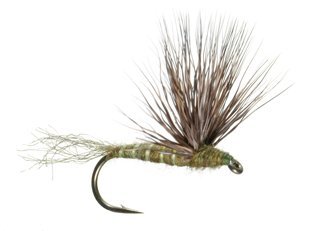
On The Fly
"Fly tying is a school from which we never graduate"
TYING NEWS
The Southern Oregon Fly Tyers invite you to attend their next meeting, Tuesday, September 8
, 2009, at 6:30 PM, at the Madrone Hill Mobile Home Park community building near Gold Hill. Bring a friend,
come early so you don't miss anything, and stay late. Tiers need not be experienced, and those with all
levels of skill are welcome. Participants are asked to donate a fly to the free raffle held at the end of
the meeting. Each meeting a member is encouraged to demonstrate a new or different skill, from simple to
difficult. For more information, call Dan Kellogg at 773-4724.
DIRECTIONS: Take Gold Hill Exit #40, off of I-5 and go west, toward Jacksonville, 1.3
miles, until you reach the brick entrance way to the Madrone Hill Mobile Home Park on the right. You’ll
pass a golf course parking lot on Your left shortly after leaving the freeway. After you turn right into the
mobile home park, proceed to the community building which is located about 100 yards ahead on the left. The
address is 8401 Old Stage Rd. Please park your vehicle on the bare dirt in the parking lot to avoid the
wooden septic covers in the grass.
 PATTERN OF THE MONTH - Light Olive Sparkle Dun
PATTERN OF THE MONTH - Light Olive Sparkle Dun
Hook: Daiichi 1170 or equal, standard dry fly size 14-22
Thread: Olive, 8-0
Wing: Light gray or dun deer hair.
Tail: Pale gray Z-lon fibers.
Body: Light Olive Antron or dry fly dubbing.
Tying Instructions
Step 1.Mash the hook barb, put the hook into your vise, start the thread behind the thread
behind the eye and lay down a thread base on the shank to just above the barb of the
hook. Spiral the thread back toward the front to the 2/3 point on the shank.
(That's 1/3 from the eye.)
Step 2. Select and cut a small bunch of deer hair from the hide, remove all under-fur and short
hair, and align the tips in a stacker. Remove the hair from the stacker with the tips
pointing forward and measure it the length of the hook shank.
Step 3. Pinch the hair firmly over the tie-in point and secure it with from eight to twelve more
tight turns over the butts towards the rear of the hook. This will prevent the hair
from moving around the back of the shank. Raise the butts and cut them at a slant
towards the rear, thus helping to form a tapered body when wrapped.
Step 4. Layer thread wraps over the butts and continue to the bend of the hook. Separate a
dozen or so Z-lon fibers from the bunch and tie them on top of the hook with the
butt end up to the deer hair butts. After securing these fibers, trim the tail to length,
one shank long. Now layer thread from the tail to the wing forming a smooth tapered
body shape. Remember the natural dun has a slender but tapered body.
Step 5. Twist a small amount of fine dubbing tightly to the thread and wind it forward from
base of the tail to the base of the wing to form the body. Use only just enough dubbing
to cover the thread base.
Step 6. Separate the rear third of the wing fibers and draw them back with your off hand,
forming a gap between the rear third and the front two-thirds. Take a single turn of
thread through this gap and seat it tightly to the hook shank. This is critical to hold
the wing upright when the fly is fished. Draw the second third of hair back, and take
a turn at the gap. Hold all the hair firmly back and take many turns of thread tight
against the front, forming a thread dam to prop the wing upright.
Step 7. Add a small amount of dubbing to the thread. Take the first turns tight against the
front of the wing, the rest tapering down to the eye. Forma neat thread head,
whip finish, and cement.
The Sparkle Dun style was developed by John Juracek and Craig Mathews of Blue
Flies in West Yellowstone, Montana. Actually it is a modification of the Compara-dun
style for mayfly duns, which was a modification of Fran Better's original Haystack,
which is a common evolutionary sequence for most new patterns. All have deer-hair
wings flared in a 160 degree arc over the body and lack hackles. The Haystack has a
deer-hair tail. The Compara-dun has split hackle fiber tails. The Sparkle dun has a
Z-lon fiber tail to represent the shuck of the nymph trailing off the back of the body
of the emerging dun.
The Sparkle Dun floats flush in the surface film and represents an emerging mayfly dun
trapped in its own shuck. It works very well if you fish over small mayfly hatches on
smooth water. In the appropriate size and color it's a great choice for picky trout on
a spring creek or tail-water mayfly emergence.
TYING TIPS
The wing hair for the Sparkle Dun, sometimes called Compara-dun hair, is fine and
solid with short black tips. The best comes from the leg of the deer. You can also use
natural or dyed coastal deer hair if the black tips are not too long.
This pattern is easy to tie, using only three common materials. My advise, learn this style!
once you have it, change the size and colors to match any hatch, anywhere, anytime.
So tie some up, give them a test flight, and let me know how you do.
Tie One On,
Dan Kellogg (you can contact me at FLYGUY@EZNORTHWEST.COM)